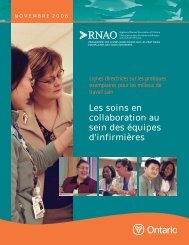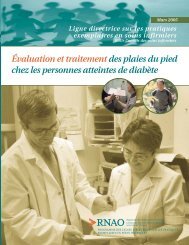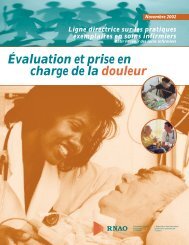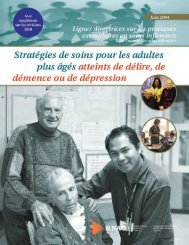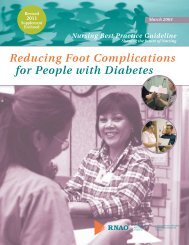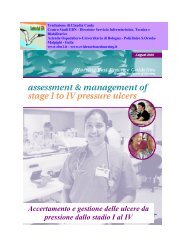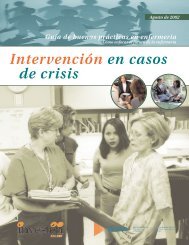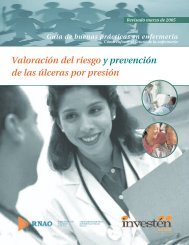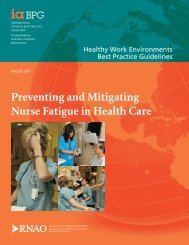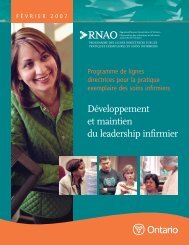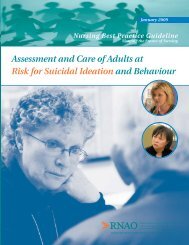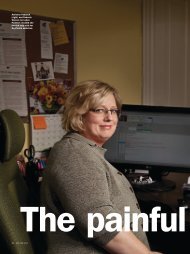lhins: bringing it all back home - Registered Nurses' Association of ...
lhins: bringing it all back home - Registered Nurses' Association of ...
lhins: bringing it all back home - Registered Nurses' Association of ...
Create successful ePaper yourself
Turn your PDF publications into a flip-book with our unique Google optimized e-Paper software.
Express adm<strong>it</strong>ting<br />
helps ease ER workload<br />
Why Nursing?<br />
Mary Timms became an RN because she wanted a career w<strong>it</strong>h<br />
unlim<strong>it</strong>ed possibil<strong>it</strong>ies. In her late twenties, she was working in<br />
computers but decided to sw<strong>it</strong>ch gears and pursue nursing, a pr<strong>of</strong>ession<br />
w<strong>it</strong>h more divers<strong>it</strong>y. After obtaining her nursing diploma<br />
from George Brown College in 1978,Timms landed a job in cr<strong>it</strong>ical<br />
care at a hosp<strong>it</strong>al on Prince Edward Island. She worked there<br />
until 1981, when she returned to Ontario to begin a summer job<br />
in the emergency department at Peterborough Regional Health<br />
Centre (PRHC).W<strong>it</strong>h the exception <strong>of</strong> a one-year stint nursing in<br />
Texas in 1994, Timms has spent 24 years at PRHC, primarily in<br />
emergency. She was part <strong>of</strong> the sexual assault team and became a<br />
sexual assault nurse examiner in the late<br />
1990s. She also occasion<strong>all</strong>y nursed on different<br />
hosp<strong>it</strong>al un<strong>it</strong>s on a temporary basis.<br />
“My heart was always in cr<strong>it</strong>ical care or<br />
emergency,” she says. “But I believe you<br />
have to appreciate other people’s jobs.”<br />
In 2003, that love <strong>of</strong> cr<strong>it</strong>ical care led<br />
Timms to help develop and work on<br />
PRHC’s patient transfer team and, in 2004,<br />
to apply for one <strong>of</strong> two pos<strong>it</strong>ions on the new<br />
Patient Express Adm<strong>it</strong>ting Team, or PEAT.<br />
Responsibil<strong>it</strong>ies:<br />
Launched last December, PEAT is unique in<br />
Ontario and modeled after a similar program<br />
in New Jersey. It’s aim is to unclog the<br />
emergency department.<br />
“Emergency has become impossible to Name: Mary Timms<br />
run because there’s a <strong>back</strong>log <strong>of</strong> in-patients,” Occupation: RN, Patient<br />
Timms says, adding that patients sometimes Express Adm<strong>it</strong>ting Team<br />
feel the admissions process is fragmented Home Town: Peterborough,<br />
and confusing. As a PEAT nurse, Timms Ontario<br />
holds some <strong>of</strong> those fragments together.<br />
PEAT patients are usu<strong>all</strong>y medical or surgical admissions who have<br />
a hosp<strong>it</strong>alist – a doctor who only sees adm<strong>it</strong>ted patients – assigned to<br />
them. The patient or family members must also be able to interact<br />
w<strong>it</strong>h the PEAT nurse and be willing to complete a survey about the<br />
admission process to help PRHC mon<strong>it</strong>or PEAT’s progress.<br />
Approximately 12 to 15 patients a day are eligible for PEAT.<br />
Timms spends over an hour w<strong>it</strong>h each patient completing a full<br />
medical history, explaining the tests or procedures a patient can<br />
expect to undergo, starting medications, screening for respiratory<br />
diseases, and keeping family members updated on their loved ones’<br />
care.Timms also notifies commun<strong>it</strong>y agencies if patients will need<br />
commun<strong>it</strong>y services once they are discharged. Once a PEAT<br />
by Jill Shaw<br />
patient leaves Timms’ care and is sent to the appropriate floor in<br />
the hosp<strong>it</strong>al, staff on that floor has his or her thorough medical history<br />
and a completed admission screening, and can direct any<br />
questions about the patient to the adm<strong>it</strong>ting PEAT nurse.<br />
Ch<strong>all</strong>enges:<br />
Timms says she and one other PEAT nurse work regular weekday<br />
shifts, and can only see medical/surgical patients who have recently<br />
arrived in the busy emergency department. More than 80,000<br />
people vis<strong>it</strong> PRHC’s emergency room every year, and if a patient<br />
has been in the emergency room over the weekend, most <strong>of</strong> the<br />
required admissions work is already done.Timms hopes PEAT will<br />
be able to hire more nurses once the program demonstrates progress<br />
in areas like reducing emergency wa<strong>it</strong>ing times, improving infection<br />
control practices and easing patient anxiety.<br />
Memories <strong>of</strong> a job well done:<br />
Timms says PEAT is working. In<strong>it</strong>ial surveys show <strong>it</strong> has slightly<br />
decreased the length <strong>of</strong> stay for pneumonia and<br />
Chronic Obstructive Pulmonary Disease patients.<br />
Feed<strong>back</strong> from other hosp<strong>it</strong>al staff indicates PEAT<br />
nurses free ER staff from some administrative<br />
duties, <strong>all</strong>owing them more time to spend w<strong>it</strong>h<br />
patients. There is also improved communication<br />
between the ER and other floors. For Timms, the<br />
most personal reward comes from working oneon-one<br />
w<strong>it</strong>h patients and providing them w<strong>it</strong>h<br />
continu<strong>it</strong>y <strong>of</strong> care.<br />
“Patients feel informed,” she says. “If they<br />
know I’m the PEAT nurse and I’ve looked after<br />
them, they are able to ask for me if they have<br />
any questions.”<br />
Future plans:<br />
Timms hopes the program will continue to<br />
reduce wa<strong>it</strong>ing times and lower lengths <strong>of</strong> stay.<br />
She hopes to see more PEAT nurses caring for<br />
more than just medical/surgical patients. There<br />
has also been some interest in the program from<br />
other hosp<strong>it</strong>als. In July, Halton Healthcare<br />
Services vis<strong>it</strong>ed to learn more about PEAT, and<br />
a hosp<strong>it</strong>al in St. John’s, Newfoundland has also expressed interest in<br />
the program.<br />
But while PEAT is growing,Timms is nearing retirement. She<br />
doesn’t think she could ever retire completely from nursing and is<br />
still open to change. She would like to use her training as a sexual<br />
assault nurse examiner to provide education in the commun<strong>it</strong>y, and<br />
has contemplated doing outpost nursing for a short time to link<br />
nursing w<strong>it</strong>h her love <strong>of</strong> the outdoors.<br />
“I’ve always been game to try something new,” she says.“Today,<br />
nursing has unlim<strong>it</strong>ed possibil<strong>it</strong>ies.” RN<br />
JILL SHAW IS ACTING COMMUNICATIONS OFFICER/WRITER AT RNAO.<br />
<strong>Registered</strong> Nurse Journal 11



